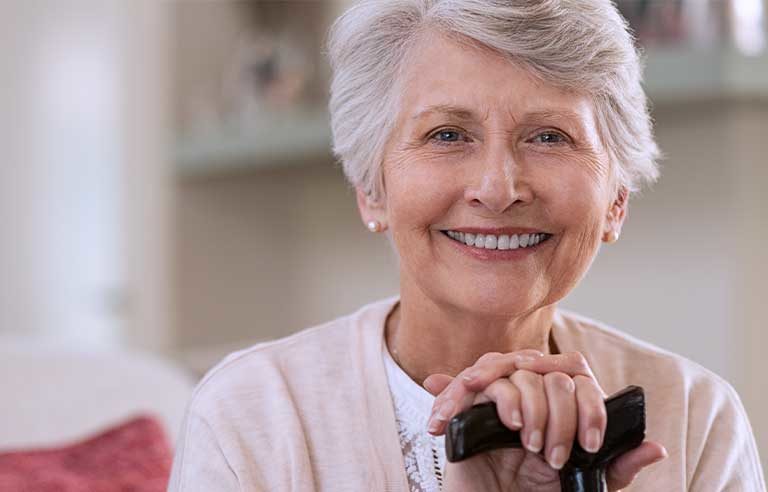Senior falls: Reduce the risk
Four steps for keeping your older loved ones safe

For many seniors, everyday tasks such as walking to the mailbox, carrying laundry or grocery shopping can increase their risk of falling. This is especially true for older adults taking certain medications or dealing with health issues or decreases in strength and mobility.
“Falls, whether you’ve had one or not as an older adult, can be devastating,” said Kristi L. Ladowski, injury prevention and outreach coordinator at the Stony Brook (NY) Medicine Trauma Center.
‘A huge concern’
Fall-related death rates among older adults rose 30 percent from 2007 to 2016, according to the Centers for Disease Control and Prevention.
“It’s a huge concern,” said Beverley L. Laubert, former director of the Ohio Department of Aging.
CDC data shows that each year, 3 million older adults are treated in emergency rooms for fall-related injuries. Further, fall-related injuries cause more than 800,000 hospitalizations every year. Of the more than 300,000 older adults admitted with hip fractures each year, more than 95 percent of the injuries were the result of a fall. Even more devastating, falls are the most common cause of traumatic brain injuries.
Four steps
So, what can people, or other caregivers, with aging loved ones do to help? Family Safety & Health gathered advice from several experts to highlight four key steps.
1. Assess the risks. “That’s a key first step,” said Emily Nabors, program manager at the Fall Prevention Center of Excellence at the University of Southern California’s Leonard Davis School of Gerontology.
The research center is a statewide resource for fall prevention, offering risk assessment and home modification guidance online at StopFalls.org.
“We stress the importance of assessing the home,” Nabors said, “not only looking for hazards, but also ways to make the environment work for the person living there, not work against them.”
Some changes are simple, such as adding a night-light to illuminate the path from a bedroom to the bathroom. Others include remodeling a bathroom to install a roll-in shower, supportive grab bars or a comfort-height toilet, Nabors said.
2. Manage medications. Robert Wahler is a clinical assistant professor at the University at Buffalo’s Department of Pharmacy Practice. He and some of his students conduct clinics where seniors socialize.
At Gloria J. Parks Community Center in Buffalo, NY, for example, seniors often enjoy lunch service, play cards and shoot pool. During an onsite clinic there, Wahler’s students identified a patient who no longer needed an antidepressant that was prescribed years ago after her husband’s death, and another who had low blood pressure but was taking medication for high blood pressure.
“We look at medications as one piece of the bigger puzzle,” Wahler said. “We want to identify those medications that put the patients at risk for a fall.”
An online national directory of senior care pharmacists is available via the American Society of Consultant Pharmacists at HelpWithMyMeds.org.
3. Improve strength and balance. The best fall prevention programs, Ladowski said, are the most well rounded, focusing on strength, cardio, balance and flexibility.
A common program for older adults is tai chi, which often is called meditation in motion. Tai chi can enhance strength, flexibility and balance, and can be done while seated.
“Targeting balance is very important,” Ladowski said. “If something is going to trip us up, our balance mechanisms can jump in and prevent a fall from happening.”
To find a fall prevention program in your area, search online for your state’s Department of Aging or a local county’s senior services coordinator.
4. Build confidence. Many evidence-based fall prevention programs involve a group setting and peer support, which are key in diminishing fears about falls. Even for some older adults who haven’t experienced a fall, fears lead them to cut back on social activities, isolate themselves and potentially become depressed.
“It creates this cycle where seniors limit daily activities,” Ladowski said. “By limiting those activities, we start to lose our muscle strength and our balance.”
Finding the right program to build confidence should start with a risk assessment “by a doctor, physical therapist or the program itself to determine where an individual is at with balance, gait and strength,” Nabors said.
Ladowski said her groups encourage storytelling and sharing. “There’s a lot of positive reinforcement,” she said.
Educating older adults on their specific risk factors, along with general risks, is an important step in any program. “Being with your peers and learning together and from each other can be a powerful experience,” Nabors said.
More about aging
Why is understanding fall prevention so important?
By 2030, 1 in 5 Americans will be at least 65 years old, and baby boomers will outnumber children for the first time in U.S. history, according to the U.S. Census Bureau.
“We want everybody to think about aging,” Laubert said. “Everybody is going to be interacting with an older person. It opens up so many opportunities for conversations.”
Post a comment to this article
Safety+Health welcomes comments that promote respectful dialogue. Please stay on topic. Comments that contain personal attacks, profanity or abusive language – or those aggressively promoting products or services – will be removed. We reserve the right to determine which comments violate our comment policy. (Anonymous comments are welcome; merely skip the “name” field in the comment box. An email address is required but will not be included with your comment.)
